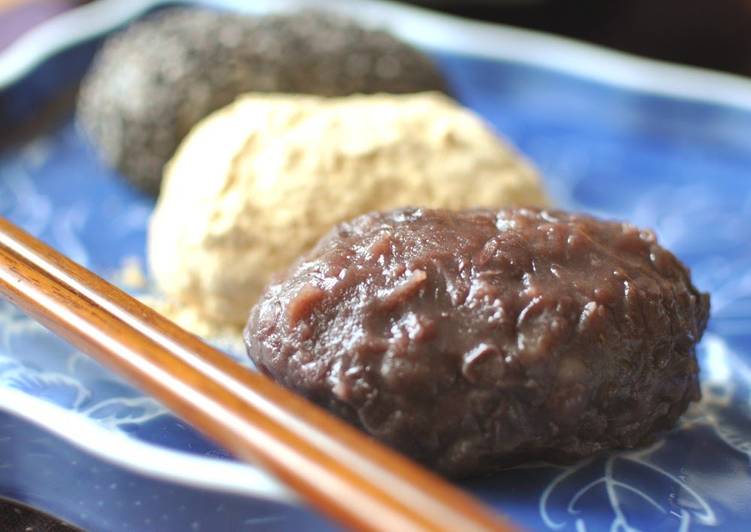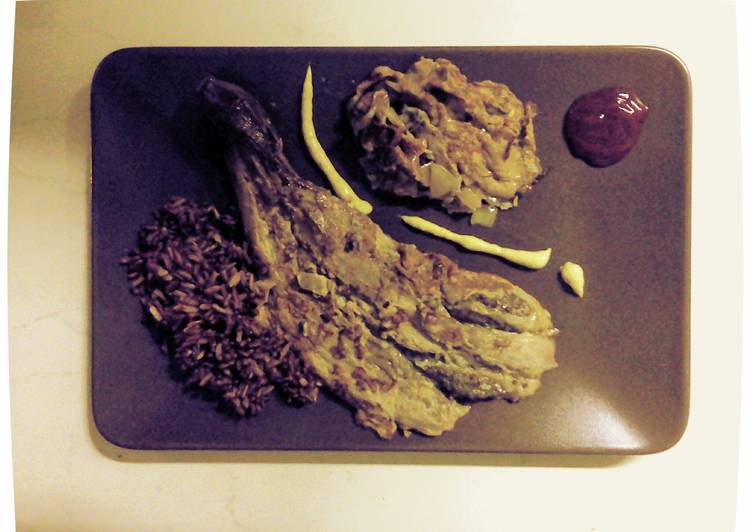
Hello everybody, it is Brad, welcome to my recipe page. Today, I’m gonna show you how to prepare a distinctive dish, spring botamochi and autumn ohagi. It is one of my favorites food recipes. This time, I’m gonna make it a little bit tasty. This will be really delicious.
Spring Botamochi and Autumn Ohagi is one of the most well liked of recent trending foods on earth. It is enjoyed by millions every day. It is simple, it is quick, it tastes delicious. They are nice and they look fantastic. Spring Botamochi and Autumn Ohagi is something which I have loved my whole life.
They are called Botamochi in spring and Ohagi in autumn. Growing up in Japan, I remember we had a lot of cultural, seasonal, and sometimes Ohagi or Botamochi is one of those special foods we enjoyed during spring and autumn equinoxes every year. They are sweet rice balls filled or coated.
To get started with this particular recipe, we must prepare a few ingredients. You can cook spring botamochi and autumn ohagi using 4 ingredients and 14 steps. Here is how you can achieve it.
The ingredients needed to make Spring Botamochi and Autumn Ohagi:
- Make ready 300 ml mochi rice
- Prepare 100 ml white rice
- Take 1/2 tsp salt
- Take Tsubu-an (sweet chunky azuki bean paste)
Some recipe variations in both cases call for a coating of soy flour to be applied to. Generally speaking, the "botamochi" is eaten in spring, while the "ohagi" is eaten in autumn. The critical difference is the "red bean filling" wrapped in rice ball outside! It is the harvest time of red beans during the Ohigan of autumn (Shūbun), the freshly harvested red beans are very soft.
Steps to make Spring Botamochi and Autumn Ohagi:
- Prepare your tsubu-an (see this recipe for my homemade tsubu-an: https://cookpad.com/en/recipes/148675) - - https://cookpad.com/us/recipes/148675-the-ultimate-anko-paste-tsubu-an
- Combine the mochi rice and white rice and rinse it. Add the rice to a rice cooker with the same amount of water as cooking regular white rice. Leave the rice to soak for 30 minutes then cook as usual. Steam for another 10 minutes.
- Transfer the rice to a bowl. Using a wettened wooden pestle, half-mash the rice.
- Using wet hands, shape the rice into the amount of botamochi and ohagi that you would like to make. Shape the tsubu-an into the same sizes.
- Pick up the balls of tsubu-an and flatten them in the palm of your hand. Add a ball of mochi rice on top. Wrap the tsubu-an around the rice whilst perfecting the circular shape.
- And the ohagi are done. For bigger ohagi it's better that the tsubu-an doesn't stretch all the way around. The plate won't get as dirty and the ohagi will be easier to pick up.
- How to make 3 kinako ohagi: Combine 2 tablespoons kinako and 3/4 to 1 tablespoon sugar in a small bowl.
- How to make 3 sesame ohagi: Ground black sesame seeds: 2 tablespoons Sugar: 3/4-1 tablespoon Combine the sesame seeds and sugar in a small bowl.
- Make the rice balls very large, about 1.5 times the size of the ones in step 4. Make the balls of tsubuan half the size of the ones in step 4.
- Place a rice ball on top of a sheet of cling film and flatten it out to around 10 cm diameter. Place a ball of tsubu-an on top.
- Gather up the wrap and use it to shape ohagi into a ball.
- Place the balls into a dish of either the kinako mixture or the sesame mixture and roll them around until completely coated. Done!
- The center should look like this.
- You can keep leftover ohagi in the freezer. Please freeze them while they are still soft. If you don't defrost them in the microwave they will stay soft.
Ohagi, or botamochi, are sweet rice balls which are usually made with glutinous rice. They are commonly eaten during higan periods in spring and autumn, a Buddhist holiday celebrated by Japanese sects during both equinoxes. The name, ohagi, came from the autumn flower, hagi (bush. Ohagi and Botamochi are traditional Japanese sweet dumplings for Higan, a public holiday in Japan. Higan happens in spring around the vernal equinox and in autumn around the autumn equinox.
So that’s going to wrap this up for this special food spring botamochi and autumn ohagi recipe. Thanks so much for your time. I am sure that you can make this at home. There’s gonna be interesting food at home recipes coming up. Don’t forget to save this page in your browser, and share it to your family, colleague and friends. Thank you for reading. Go on get cooking!

